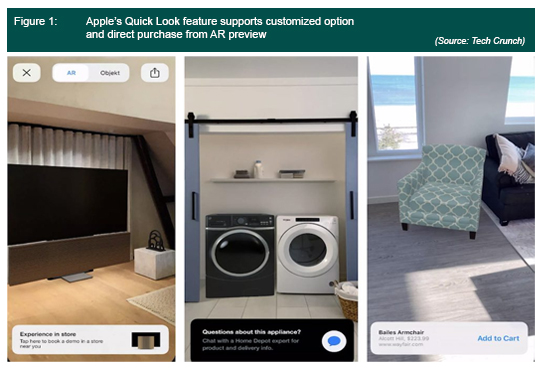1Q 2020 | IN-5754
Registered users can unlock up to five pieces of premium content each month.
iOS Users Will Be Able to Directly Purchase Products from AR Preview |
NEWS |
Apple recently expanded the capabilities of the Augmented Reality (AR) Quick Look ARKit feature for iOS 13.3 and later to allow retailers to add a customized option/website link and enable direct purchases from AR preview by using Apple Pay. The Quick Look feature, introduced in 2018 with the release of ARKit 2, allows retailers to upload 3D models of their products and enables users to visualize the products’ actual dimensions and place them in their prospective environments using Apple’s Safari browser instead of a separate app. The capabilities of Quick Look were initially limited to AR preview (scale and sharing through iMessage and email), and users needed to exit Quick Look preview and visit the retailer’s website or app to search for extra information, contact customer service support, or purchase items. Additionally, Apple is planning to include spatial audio to enhance Quick Look and generate more immersive experiences. For example, 3D models will “produce” sounds in accordance with their location in a space, their size, or a user’s position in the environment.
 |
Quick Look's New Features Help Better Establish AR Online Shopping |
IMPACT |
Virtual try-on and AR product visualization can revolutionize online shopping/e-commerce by increasing customer engagement and optimizing the shopping experience. More specifically, the implementation of AR solutions for online shopping allows customers to experiment and visualize products before purchasing them and be aware of how they would look in the real world at accurate scale. More and more retailers are embracing AR previews and virtual try-on as a key part of their digital marketing strategies, including businesses from various industries (cosmetic, consumer tech, furniture. etc.). The experience so far has proven that customers who tend to spend more time experimenting with products are more likely to purchase them, and when customers try products in advance, they tend to feel more confident about their purchasing decisions, resulting in fewer returns and higher satisfaction.
The implementation of direct payment (via Apple Pay), product customization options, live chat, and eventually spatial sound support are all part of the maturity process, which will help AR product previews move beyond demonstration/customer engagement and get established as an independent concept/process, rather than only a complimentary tool. This will ultimately include all steps of traditional online shopping (3D preview, payment/delivery options, live chat, customized options). At the same time, one of the most significant impacts of direct purchases from AR mode is that there will be a clear-cut Return on Investment (ROI) story, providing clear and direct metrics about actual AR-based purchases and the success of AR marketing campaigns. Finally, enablement through Apple Pay can maintain user/business traffic on Apple’s platform, increase user engagement, and strengthen service revenues/usage rate.
Revenues from Retail, Commerce, and Marketing in AR Market Will Reach More Than US$7.5 Billion by 2024 |
RECOMMENDATIONS |
AR shopping has not yet been established as an independent concept; currently, AR is used as a marketing tool or supplemental part of the shopping process, suitable for a limited range of products and only achieving optimal performance in certain devices in specific regions. Thanks to advancements like direct AR integration in Apple Pay, it is anticipated that revenues from retail, commerce, and marketing in the AR market will significantly increase and will reach approximately US$7.5 billion in revenue by 2024, increasing from over US$600 million in 2020. Revenues include spending both in physical stores and online shopping by leveraging AR solutions.
AR online shopping has the potential to reach the success of traditional online shopping, in terms of AR based purchases, in certain industries. However, it requires technological enhancements to reach its full potential; for instance, AR product previews need to be realistic and accurate to encourage actual AR purchases, which requires a great deal of new content creation and existing content optimization to cover a notable amount of total product. Also, in order to drive (online) traffic and revenues from AR sales, providers need to expand the range of available products and reduce loading time to improve User Experience (UX) and entice and retain users. In addition, payment method flexibility and reliability will contribute in driving AR purchases; it has been already proved from traditional online shopping that a range of payment options in combination with security has assisted in the growth of online shopping.
Technological advancements in mobile devices (cameras, processors, graphics) in combination with mobile Software Development Kits (SDKs) updates are also catalytic for supporting realistic and accurate AR concepts. Furthermore, the establishment of WebXR solutions for product preview is essential for encouraging wider usage, enabling a process as smooth and easy as online shopping is today. At the same time, WebXR capabilities encourage more retailers to introduce AR experiences in their marketing campaigns/online shopping, thanks to the lower cost and the removal of the need for a separate app.
All in all, updates in AR shopping tools optimize UX and allow the concept to mature and be embraced by retailers and users. At the same time, one of the main tangible goals is to drive users that are experimenting with AR toward actual buyers, which becomes easier as AR technology and the AR market mature.